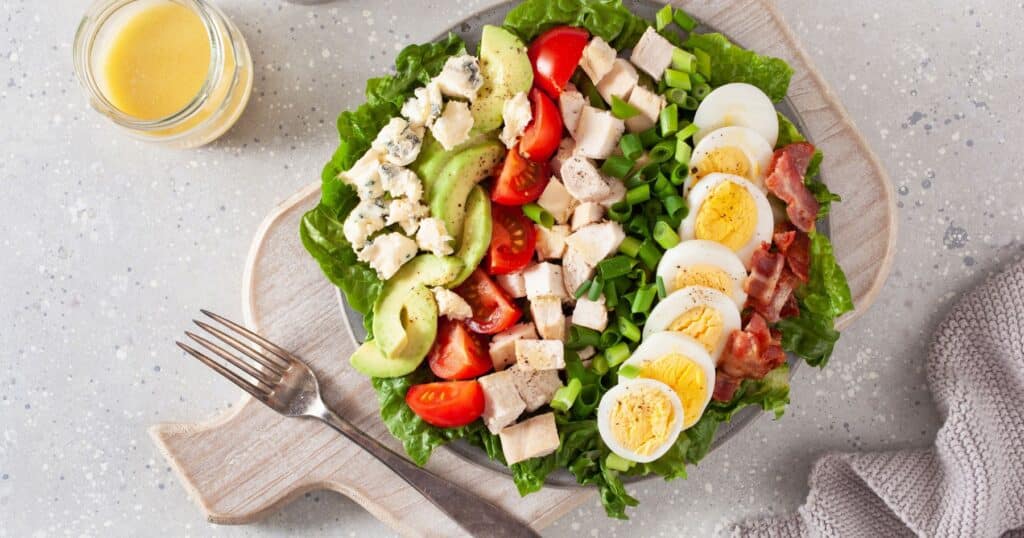Level Up Your Nutrition Game With Our Freebies
Alex
I provide nutrition coaching for endurance athletes to improve performance and body composition through a simple and flexible eating style.
Hi, I'm
ATHLETE EATING GUIDE →
LEARN MORE →
ATHLETE GROCERY SHOPPING GUIDE →
10-DAY PROTEIN-PACKED SAMPLE MEAL PLAN
READY TO FUEL?
incredible value!
The fueling guide bundle serves as your one-stop-shop for strategies to fueling before, during and after your workouts.
So often are we bombarded with a new diet trend that promises things like weight loss, increased energy levels, and even decreased “bloating” for athletes. While lower-carb diets can be a helpful tool for the average person, endurance athletes are anything but average. So let’s dive in and review if you should be running on a low-carb diet.
Understanding Low-Carb Diets

A low-carbohydrate diet is a dietary pattern that restricts the consumption of carbs. Carbs are primarily found in foods like grains, bread, pasta, rice, sweetened beverages, and sugary snacks. Boo hoo – unfortunately you are restricting some of our favorite foods here at ALN. Instead, a low-carb is typically less flexible and emphasizes protein-rich and higher-fat foods including meat, fish, cheese, and other high-fat dairy sources, oils, eggs, and nuts.
Following a low-carb diet has been touted for reducing the body’s reliance on carbohydrates for energy and promoting the utilization of stored fat as a fuel source. By limiting carb intake, dieters are aiming to regulate blood sugar levels, promote weight loss, and improve overall metabolic health.
Varying Forms of Low-Carb Diets
There are varying forms of low-carb diets. They range from extremely strict ketogenic diets, where carb intake is severely restricted to induce a state of ketosis, to more moderate approaches. Moderate approaches allow for some carbohydrates while emphasizing whole, unprocessed foods. Low-carb diets have gained popularity for their potential benefits in managing conditions like obesity, type 2 diabetes, and metabolic syndrome.
While the spectrum of a low-carb diet varies in strictness, typically balancing macronutrients is a main focus. Protein intake is around 30% of total calorie intake, healthy fats are around 40-50%, and carbohydrates are limited to ~20% of calorie intake.
A strict ketogenic diet suggests the average daily calorie intake breakdown to look as follows: 70-80% from fat, 10-20% from protein, and 5-10% from carbs. This is usually less than 50 grams of carbs per day for most people strictly following the plan.
Carbohydrates are Premium Fuel

When fueling those miles, carbohydrates are considered premium fuel for filling your nutrition tank. When you consume carbohydrates, your body breaks the food into glucose (sugar) and either uses it for activity (i.e. an upcoming run) or converts it into glycogen to be used later. Typically, most runners require at least 55% of their calorie intake from carbohydrates while in-season. However, this can vary based on factors. Such as duration and intensity of run, environmental considerations such as altitude, weather patterns, and carbohydrate-loading for an upcoming race. It’s important to recognize that not all carbohydrates are the same. During training, athletes will be consuming both simple and complex carbohydrates for fuel.
Simple carbohydrates:
Simple carbs are easy to digest and are found in a variety of sources. Including: raw sugar, energy gels, energy or sports drinks, energy bars, fruit and fruit juices, soda, candy, and foods with added sugars such as cookies and desserts. Simple carbohydrate foods are typically low in dietary fiber and break down quickly to be used as energy. These foods are effective while training to provide quick bursts of energy. During your training runs, it is imperative to take in enough simple carbohydrates so that you do not run out of fuel in your tank. Typically 30-90g of simple, easy-to-digest carbohydrates per hour is the target range for most runners.
Complex carbohydrates:
Complex carbs take longer to digest and are found in higher fiber, nutrient-dense foods. Such as, whole grains (barley, brown rice, quinoa, oats), legumes including beans and lentils, and starchy vegetables such as sweet potatoes and pumpkin, among others. These foods are excellent to include throughout the day in meals and snacks to boost your vitamin and mineral intake and help keep you feeling satisfied.

Pros and Cons of Running on a Low-Carb Diet
It is important to do thorough research if you are considering following a low-carb diet. Let’s weigh the pros and cons.
Pros to running on a low-carb diet.
Exercising on a low-carb diet can offer several advantages including:
- Increased fat oxidation. By reducing carbohydrate intake, the body becomes more efficient at burning stored fat for energy. This can potentially helping with weight loss and body composition improvement.
- Stabilized blood sugars and improve insulin sensitivity, reducing the risk of type 2 diabetes.
- Decreased gastrointestinal issues. Fewer carbs and less fiber intake may reduce the risk of gastrointestinal discomfort during training. Though this varies largely from person to person.
Cons to running on a low-carb diet.
Exercising on a low-carb diet can have significant drawbacks including:
- Compromised performances, particularly at higher intensities (above lactate threshold).
- Relative Energy Deficiency in Sport or RED-S.
- Prolonged recovery and increased muscular fatigue and soreness.
- Inadequate micronutrient intake due to nutrient-rich foods being omitted from the diet.
- Potential muscle loss. In some cases, a low-carb diet might lead to muscle breakdown which can negatively impact strength and power.
- Increased psychological stress. The restrictive nature of low-carb diets may lead to stress, anxiety, or cravings, negatively affecting an athlete’s well-being.
- Increased gastrointestinal issues including constipation or irregular bowel movements.
- Other side effects of following a strict ketogenic diet that include: “keto” breath, dehydration, increased cholesterol, and even kidney stones.
The Long-Term Effects of Running on a Low-Carb Diet

Long-term adherence to a low-carb diet can have both potential benefits and risks for overall health. Research has shown that low-carb diets can lead to weight loss, improved blood sugar control, and improved lipid profiles. However, this has been most researched in individuals who are overweight or considered obese. The research is not necessarily reflective of the runner or endurance athlete population. Some individuals also report better control over hunger and cravings, which can help with weight maintenance over time.
On the flip side, there are major concerns regarding the potential adverse effects of a low-carb way of life. Prolonged restriction of carbs may result in nutrient deficiencies. Particularly in essential vitamins and minerals found in fruits, vegetables, and whole grains. The diet’s emphasis on high-fat and protein-rich foods might lead to increased saturated fat intake. This could raise the risk of heart disease if not carefully balanced. Moreover, long-term adherence to a very low-carb ketogenic diet may also have adverse effects on kidney function and bone health.
An Alternative to Strict Low-Carb Diets
For endurance athletes, maintaining a moderate carbohydrate intake diet is ideal. Carbs provide a primary energy source for performance, and moderate intake ensures adequate glycogen stores for endurance and strength training. This approach promotes stable blood sugar levels, sustained energy, and optimal athletic performance.
But What About Body Composition Goals?
Many endurance athletes desire to shed unwanted pounds to make themselves a more competitive athlete. If you are looking to improve your body composition, it is important to do so during the off-season so that it does not negatively affect your training. Endurance athletes often prioritize fat loss during the off-season rather than in-season to maximize performance gains.
In the off-season, there’s more flexibility to adjust nutrition and training plans without the pressure of upcoming races.
This approach allows endurance athletes to build a solid foundation of fitness, improve body composition, and develop sustainable habits. Shedding nonessential body fat during the off-season can also reduce the risk of overtraining, RED-S, and injury. This ensures a healthier and more successful in-season performance.
Certainly, you can chip away at body composition goals by reducing discretionary calorie intake. This implies cutting back on energy-dense foods that are high in fat, high in sugar, and offer little to no nutritional value. Furthermore, body composition goals are achievable by increasing your consumption of lean proteins, fruits, and vegetables, and decreasing your carbohydrate intake. However, this does not imply that your carb budget needs to dwindle completely.
How We Can Help
There is no one-size-fits-all approach to endurance athlete nutrition. Fortunately, you can fuel your miles without needing to cut your carb intake entirely. If you are looking to improve your nutrition intake and don’t know where to start, be sure to reach out. Through the ALN 1:1 nutrition coaching program we provide personalized accountability. We strive to teach you how to create a sustainable and flexible eating style to meet your needs as an endurance athlete.
Alex
I provide nutrition coaching for endurance athletes to improve performance and body composition through a simple and flexible eating style.
Hi, I'm
LEARN MORE →
take the quiz!
Let's discover your Endurance Nutrition IQ
How well do you know your fueling? Answer these questions and let's see where your endurance nutrition knowledge is at!
Take the quiz
level up your nutrition game with these freebies
free downloadS
Protein-Packed 10-Day Sample Meal Plan
Athlete Eating Guide
Athlete Grocery Shopping Guide
1
2
3
Inspiration to fit 120 grams of protein into your day
Planning what goes on your plate
Putting the right foods in your grocery cart
